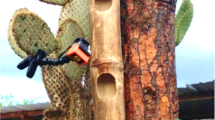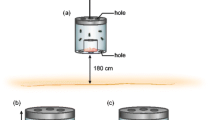Abstract
The pseudoscorpion Dinocheirus arizonensisinhabits rotting saguaro cactus in the Sonoran Desert and has also been found attached to the legs of the cactophilic neriid fly, Odontoloxozus longicornis.Laboratory experiments demonstrated a higher incidence of phoresy on eclosing versus postteneral adult flies, a female bias in phoresy, and an increased rate in female phoresy through time. The pseudoscorpion may also prey on the fly, but predation rate was unaffected by fly category, pseudoscorpion gender, or food deprivation. A study of pseudoscorpion colonization in the field indicated that females were the first to colonize and the first to abandon the transient habitat of a saguaro rot and, thus, corroborated patterns of phoretic behavior in the laboratory. Taken together, these results establish that phoresy is a behavior functioning specifically for dispersal. The hypothesis that pseudoscorpion transport by other arthropods is accidental, motivated by hunger, and occurs because pseudoscorpions are incapable of consuming their hosts is rejected.
Similar content being viewed by others
References
Beier, M. (1948). Phoresie und Phagophilie bei Pseudoscorpionen.Oesterreich. Zool. Z. 1: 441–497.
Chamberlin, J. C., and Malcolm, D. R. (1960). The occurrence of false scorpions in caves with special reference to cavernicolous adaptation and to cave species in the North American fauna.Am. Midl. Nat. 64: 105–115.
Clausen, C. P. (1976). Phoresy among entomophagous insects.Annu. Rev. Entomol. 21: 343–368.
Dixon, W. J. (ed.), (1983).BMDP Statistical Software, University of California Press, Berkeley.
Haack, R. A., and Wilkinson, R. C. (1987). Phoresy byDendrochernes pseudoscorpions on Cerambycidae (Coleoptera) and Aulacidae (Hymenoptera) in Florida.Am. Midl. Nat. 117: 369–373.
Hamilton, W. D. (1978). Evolution and diversity under bark. In Mound, L. A. (ed.),Diversity of Insect Faunas, Blackwell, Oxford, pp. 154–175.
Hinton, H. E. (1977). Enabling mechanisms.Proc. XV Int. Entomol. Soc. 15: 71–83.
Hoff, C. C. (1959).The Ecology and Distribution of the Pseudoscorpions of North-Central New Mexico, University of New Mexico Press, Albuquerque.
Legg, G. (1975). The possible significance of spermathecae in pseudoscorpions (Arachnida).Bull. Br. Arachnol. Soc. 3: 91–95.
Levins, R. (1968).Evolution in Changing Environments, Princeton University Press, Princeton, N.J.
Lindquist, E. E. (1975). Associations between mites and other arthropods in forest floor habitats.Can. Entomol. 107: 425–437.
Lloyd, J. E., and Muchmore, W. B. (1975). Pseudoscorpions phoretic on fireflies II.Fla. Entomol. 58: 241–242.
Mangin, R. L. (1979). Reproductive behavior of the cactus fly,Odontoloxozus longicornis, male territoriality and female guarding as adaptive strategies.Behav. Ecol. Sociobiol. 4: 265–278.
Mangin, R. L. (1984). Reproductive ecology of three cactophilic Diptera (Diptera: Drosophilidae, Neriidae, Syrphidae).Pan-Pacific Entomol. 60: 326–331.
Matsuda, R. (1979). Abnormal metamorphosis and arthropod evolution. In Gupta, A. P. (ed.),Arthropod Phytogeny, Van Nostrand Reinhold, New York, pp. 137–256.
Mitchell, R. (1970). An analysis of dispersal in mites.Am. Nat. 104: 45–431.
Moser, J. C., and Cross, E. A. (1975). Phoretomorph: A new phoretic phase unique to the Pyemotidae (Acarina: Tarsonemoidea).Ann. Entomol. Soc. Am. 68: 820–822.
Muchmore, W. B. (1971). Phoresy by North and Central American pseudoscorpions.Proc. Rochester Acad. Sci. 12: 79–97.
Muchmore, W. B. (1982). Pseudoscorpionida. In Parker, S. P. (ed.),Synopsis and Classification of Living Organisms, Vol. 2, McGraw-Hill, New York, pp. 96–102.
Muchmore, W. B., and Alteri, C. H. (1974). The genusParachernes (Arachnida, Chelonethida) in the United States, with descriptions of new species.Trans. Am. Entomol. Soc. 99: 477–506.
Parker, G. A., and Stuart, R. A. (1976). Animal behavior as a strategy optimizer: Evolution of resource assessment strategies and optimal emigration thresholds.Am. Nat. 110: 1055–1076.
Roff, D. (1986). The evolution of wing dimorphism in insects.Evolution 40:1009–1020.
Rosenthal, R., and Rosnow, R. L. (1985).Contrast Analysis: Focused Comparisons in the Analysis of Variance, Cambridge University Press, Cambridge.
Smiley, R. L., and Moser, J. C. (1976). Two new phoretomorphicSiteroptes from galleries of the southern pine beetle.Beitr. Entomol. Berlin 26: 307–322.
Steenbergh, W. F., and Lowe, C. H. (1977).Ecology of the Saguaro: II. National Park Scientific Monograph Series, No. 8.
Vachon, M. (1940). Remarques sur la phoresie des pseudoscorpions.Ann. Soc. Entomol. Fr. 109: 1–18.
Vachon, M. (1954). Nouveaux cas de phoresie chez les pseudoscorpions.Bull. Mus. Hist. Nat. Paris 2: 572–575.
Weygoldt, P. (1969).The Biology of Pseudoscorpions, Harvard University Press, Cambridge, Mass.
Wilson, D. S. (1980).The Natural Selection of Populations and Communities, Benjamin/Cummings, Menlo Park, Calif.
Wilson, D. S. (1982). Genetic polymorphism for carrier preference in a phoretic mite.Ann. Entomol. Soc. Am. 75: 293–296.
Wilson, D. S. (1983). The effect of population structure on the evolution of mutualism: A field test involving burying beetles and their phoretic mites.Am. Nat. 121: 851–870.
Zeh, D. W. (1986).Ecological Factors, Pleiotropy, and the Evolution of Sexual Dimorphism in Chernetid Pseudoscorpions, Ph.D. dissertation, University of Arizona, Tucson.
Zeh, D. W., and Zeh, J. A. (1992a). Dispersal-generated sexual selection in a beetle-riding pseudoscorpion (in press).
Zeh, D.W., and Zeh, J. A. (1992b). Emergence of a giant fly triggers phoretic dispersal in the neotropical pseudoscorpionSemeiochernes armiger (Pseudoscorpionida: Chernetidae).Bull. Br. Arachnol. Soc. (in press).
Zeh, D. W., and Zeh, J. A. (1992c). On the function of harlequin beetle-riding in the pseudoscorpionCordylochernes scorpioides (Pseudoscorpionida: Chernetidae).J. Arachnol. (in press).
Author information
Authors and Affiliations
Rights and permissions
About this article
Cite this article
Zeh, D.W., Zeh, J.A. Failed predation or transportation? Causes and consequences of phoretic behavior in the pseudoscorpionDinocheirus arizonensis (Pseudoscorpionida: Chernetidae). J Insect Behav 5, 37–49 (1992). https://doi.org/10.1007/BF01049156
Accepted:
Issue Date:
DOI: https://doi.org/10.1007/BF01049156




